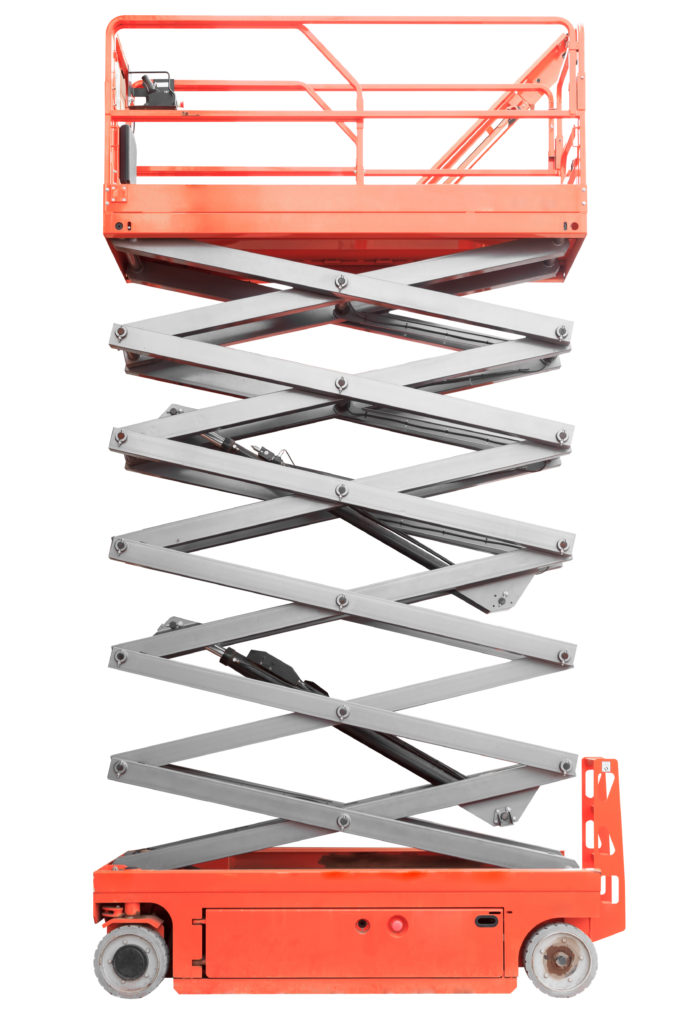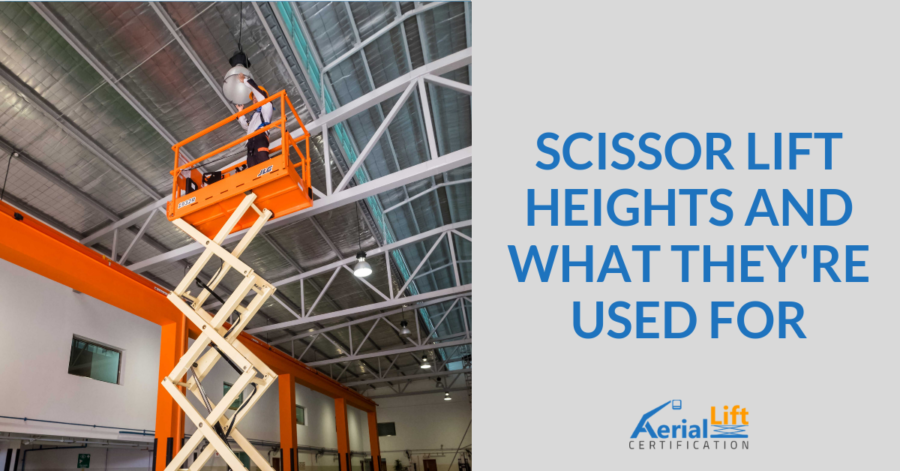The Scissor Lift Sizes You Should Know About
Scissor lifts are designed to move vertically and help workers reach new heights. Named for the X pattern design of the lifting mechanism, the scissor lift extends a horizontal platform upwards. Some models operate by hydraulics. Others use pneumatics or mechanical means to lift workers up. Whatever model your organization opts to use, there’s no denying how useful scissor lifts are on construction sites, in warehouses, and in other industrial spaces.
When choosing the right scissor lift for the task at hand, scissor lift sizes must enter into the equation. When discussing scissor lift size or height, the lift is rated based on the highest point the platform reaches. However, you can typically figure a functional height is 6 feet higher than scissor lift height, allowing for the roughly 6-foot tall worker standing on it. The maximum platform height plus 6 feet for the worker is called the scissor lift’s working height.
No matter which scissor lift dimensions your project demands, it’s important that all operators are fully trained and certified before climbing onboard. A thorough understanding of the operational best practices can make all the difference in terms of workplace safety. Be sure your workers are fully trained and certified to safely handle all scissor lift sizes with OSHA-approved aerial lift training from AerialLiftCertification.com!
Scissor Lift Height Ranges
Scissor lift sizes range from 19 feet to 50 feet. While you might think bigger is automatically better, the smaller options have their own unique benefits. If you’re in the market for a new or used scissor lift for your organization, consider the following options:
○ 19-ft. Scissor Lift


These models are best for narrow and ideal for fitting into tight spaces, and they offer limited flexibility. They work well for accessing ceilings and ductwork inside buildings. The typical ceiling height is about 10 ft. But with a maximum reach height of 25 ft, these models can handle a wide variety of ceiling heights. If you could get a scissor lift up there, you could access the top of George Washington’s nose on Mount Rushmore! One of the benefits of this scissor lift size is that it decreases the hazards of ceiling crushes when working in tight spaces or other indoor tasks. This lift is also suitable for outdoor jobs as long as the surface is stable.
○ 26-ft. Scissor Lift
This scissor lift size is built with a wide platform, and it is best for jobs that require heavy equipment. It has a working height of about 32 ft., allowing it to reach the third story of a building. Common job applications include washing or repairing windows and other external maintenance work.
○ 32-ft. Scissor Lift
Designed for taller jobs, a 32-foot scissor lift size can achieve a working height of 38 ft. It is ideal for workers who need to access telephone and power cables that must be repaired or replaced. One of the benefits of this scissor lift size is that it allows the worker to work at the extended height for long periods. They are often found at construction sites and for maintenance jobs.
○ 45-ft. Scissor Lift
This model is similar to the 32-ft. scissor lift, just with a greater reach. A 45-ft. scissor lift height is best for workers who need to access tall buildings. It may be beneficial for those who need to access elevated signs as well. For example, this would be the perfect scissor lift size to access the top of the famous Hollywood sign.
○ 50-ft. Scissor Lift
A 50-foot scissor lift size is best for workers who require maximum height. It can access the fifth story on a building or a tall tree — about as high as most scissor lifts can go. These lifts are often designed specifically for rough terrain since they are used outdoors. A rough terrain scissor lift can reach great heights and is designed to handle rugged terrain. They come with other features and may include dual-fuel capability for more versatility.
Consider the job that needs to be completed to determine the scissor lift height range you require. Next, let’s consider the general price range, based on scissor lift size.
Working with Scissor Lifts and the Benefits
Scissor lifts use crisscrossed folding supports to raise the work platform to the scissor lift height. Pressure is applied to the outside of the lowest set of supports. This elongates the crossing pattern and lifts the platform vertically. Lowering the platform can be a powered operation, or as simple as releasing the hydraulic or pneumatic pressure. This allows for a safe return of the platform to the ground without needing power.
Scissor lifts offer many advantages over ladders and scaffolding. They are easy to operate and move from one job site to another. They have the flexibility to handle many different types of job tasks. Consider the following scissor lift benefits:
- Operator Safety – Far safer than ladders, a scissor lift raises a solid, sturdy platform vertically to the full scissor lift height. Railings surround the platform to prevent falls.
- Scissor Lift Height – Scissor lifts take worker safety to new heights, securely lifting 2-4 people. The lift also accommodates heavy machinery, lifting it safely to be used or installed at height.
- Platform Size – In addition to lifting multiple people with tools and heavy machinery, the large, stable platform allows a single worker to change their position along a wall several times before moving the lift. It enables a person to cover more space before repositioning the lift.
- Storage & Versatility – Even the largest scissor lift size folds into a relatively small space, allowing easy storage. It is easy to move to reposition for further work or put away after the task is finished.
- Electric Options – Electric scissor lifts work quietly and without emissions, making them perfect for indoor worksites. Most indoor scissor lifts come with tires that won’t mark your flooring.
Factors to Consider When Choosing a Scissor Lift
Shopping around for a new or used scissor lift can be intimidating at first. If you’re unsure of where to begin your search, start by thinking about why you need a scissor lift in the first place. Scissor lift dimensions can dictate which models are right for your project – after all, you want to make sure your new purchase can fit through your doorway! Lift and lower speeds should play a factor into your decision, too. How fast a lift can rise and lower can have a huge impact on productivity.
Once you’ve narrowed the field a bit, consider operator controls and how intuitive they are. The easier the lift is to manuever, the less time you’ll waste positioning it into the perfect spot. Of course, scissor lift heights must also be factored into your purchase. Be sure to compare the platform height with the working height. Typically, the working height is the platform height plus six feet, though this will vary based on operator height and arm length.
Safety features should also be considered when you’re shopping for a scissor lift. Tilt alarms and anti-rollback features can go a long way to prevent on the job accidents. Be sure to factor in job site conditions when making your decision – an indoor job on flat, smooth surfaces will require smaller wheels than rough terrain will.
Average Scissor Lift Prices
The average price of scissor lifts vary depending on variables like the type of motor — electric, gas, diesel, or dual-fuel — as well as the scissor lift size. Now, let’s look at the average prices for some of the most-popular sized lifts:
– 19-ft. Scissor Lift: $10,000 to $15,000
– 26-ft. Scissor Lift: $15,000 to $25,000
– 32-ft. Scissor Lift: $25,000 to $40,000
– 45-ft. Scissor Lift: $40,000 to $55,000
– 50-ft. Scissor Lift: $55,000 to $70,000
Cost is an important factor in assessing different types of scissor lifts, but it should not be the only consideration in your quest to find the right lift for your worksite. Instead, you must consider the task at hand and the safety of your aerial lift operators. You can then select a scissor lift size that helps you maximize the return on your investment. Additionally, you can provide your workers with the training they need to safely operate your scissor lift of choice.
Scissor Lift Height: How High Does a Scissor Lift Go?
One of the most common questions our training experts receive is: how high can a scissor lift go? Scissor lifts can extend as high up as 60 ft., or about one-third the height of the tallest aerial lift. Most working heights range from 20-40 ft. Scissor lifts have less reach power than boom lifts but can hold more weight. Many scissor lifts have an unrestricted weight limit of 1,000 lbs. With others, restricted weight limits can go even higher. This makes them ideal for jobs that involve the movement of heavy weight. For example, carrying heavy building materials on a construction site or heavy equipment to perform repair or maintenance work.
Regardless of your scissor lift height limit, OSHA requires training and certification to ensure a safe work environment. Just as scissor lifts heights are restricted., untrained workers are restricted from operating scissor lifts!
Small Scissor Lifts: The “Short Side” of Scissor Lift Height Limits
Sometimes you need a small scissor lift for a small job. In those situations, companies often turn to “mini” scissor lifts. These models can vary in size, with some as small as 4 ft. wide. The maximum height reach for mini scissor lifts is about 19 ft. These small lifts have a smaller work platform that makes them ideal for one-person jobs. These scissor lift sizes make them perfect for indoor use. Despite their scissor lift height limitations, mini lifts still offer big-time performance attributes!
Small scissor lifts are safer than ladders. They are easier to set up and take down than scaffolding, partly due to their scissor lift height restrictions. And most run on electric power, so they don’t emit hazardous fumes like gas-powered models. Mini scissor lifts are often used to navigate tight aisles inside warehouses to access hard-to-reach areas. Scissor lifts are ideal for indoor painting and repairs for areas unsafe or inaccessible with ladders. They also come in handy for routine maintenance and other light-duty tasks at lower heights.
Get Fast, Affordable Online Training with ALC
Once you’ve got a handle on scissor lift sizes, you may feel ready to make a purchase and get started on your next project. Regardless of your equipment or goals, OSHA requires training and certification to handle the lift safely and prevent accidents before they are allowed to operate a lift. Even on a small scissor lift, hazards like unstable work surfaces and bad weather can cause major accidents. Be prepared to operate any size scissor lift in a safe and compliant manner with OSHA-approved scissor lift training today from ALC.
AerialLiftCertification.com (ALC), the leader in online OSHA-approved certification, offers three different training courses to keep you compliant. The Train a Trainer course allows you to establish a safety expert in your company for all types of aerial lifts and all sizes. The Operator Training Kit is a complete solution to train all lift operators in your organization. With the Bundle and Save package, you get both courses at a discount to ensure your company is always 100% OSHA certified.
We can fully train and certify your employees within 1 hour. When you’re ready to elevate your safety program, contact us or call us today at (888) 278-8896.

